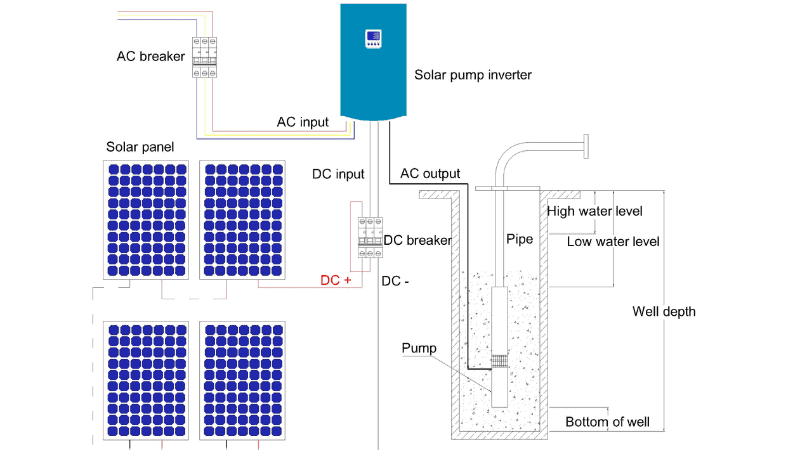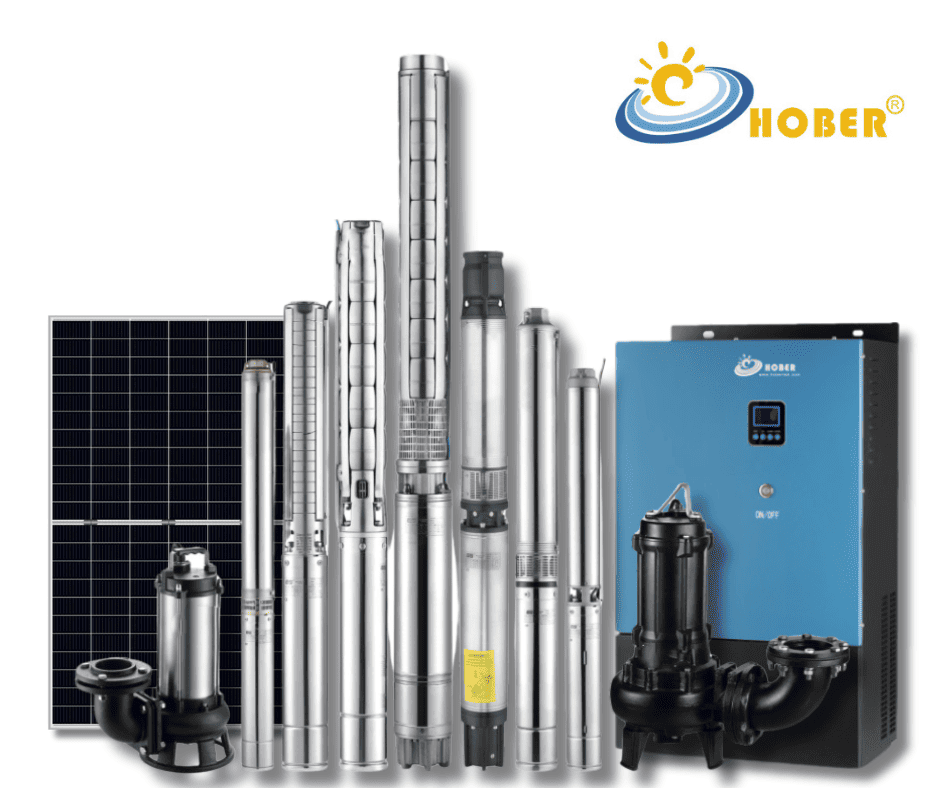Introduction
Installing water level sensors for solar pumps ensures efficient water management and prevents pump damage due to dry running or overflow. This guide provides a step-by-step process to help you install these sensors correctly, ensuring optimal performance of your solar pump system.

Why Install Water Level Sensors?
Water level sensors are essential for several reasons:
- Prevent Dry Running: Dry running can damage the pump by causing it to overheat. Sensors ensure the pump operates only when there is sufficient water, protecting it from damage.
- Avoid Overflow: By monitoring water levels, sensors can prevent tanks from overflowing, conserving water and avoiding wastage.
- Energy Efficiency: Sensors optimize pump operation, ensuring it runs only when needed, saving energy and extending the pump’s lifespan.
- Improved Water Management: Accurate monitoring allows for better management of water resources, particularly in agriculture and residential settings.
- System Protection: By detecting anomalies in water levels, sensors can help identify issues early, preventing potential system failures and reducing maintenance costs.
Choosing the Right Sensor
Factors to Consider
When selecting a solar pump water sensor, consider the specific requirements of your application. Different applications may require different sensor types, such as soil moisture sensors for irrigation or water level sensors for tanks.
Environmental Conditions
Ensure the sensor is suitable for the environmental conditions it will be exposed to, such as temperature range and exposure to elements.
Compatibility
Check compatibility with the existing solar pump system and controller to ensure seamless integration and operation.
Types of Solar Pump Water Sensors
Float Switch Sensors
Float switch sensors are one of the most common types of water sensors used in solar pump systems. They consist of a buoyant device (the float) attached to a switch. As the water level changes, the float moves accordingly, triggering the switch.
Detailed Operation
Rising Water Level: When the water level rises, the float lifts, causing the switch to close (or open, depending on the design), signaling the pump to stop (or start) pumping.
Falling Water Level: Conversely, as the water level drops, the float descends, triggering the switch to either start or stop the pump, preventing dry running or overflow.
Use Cases
Float switch sensors are typically used in water tanks and wells to manage water levels efficiently. They are simple, reliable, and effective for basic water level monitoring.
Capacitive Water Level Sensors
Capacitive sensors offer more precise measurements by detecting changes in capacitance caused by the presence of water. These sensors are capable of continuous monitoring, making them suitable for applications that require high accuracy.
Detailed Operation
Capacitance Change: The sensor consists of two conductive plates separated by a dielectric material. When water (which has a different dielectric constant than air) comes between the plates, it changes the capacitance.
Signal Transmission: The sensor detects this change and sends a signal to the pump controller, which adjusts the pump’s operation based on the water level.
Applications
Capacitive water level sensors are often used in scenarios where precise water level monitoring is crucial, such as in industrial processes or sophisticated irrigation systems.
Soil Moisture Sensors
Soil moisture sensors are vital for irrigation systems. They measure the amount of water in the soil, ensuring that plants receive the optimal amount of water, thus preventing over or under-watering.
Detailed Operation
Volumetric Water Content: These sensors often use probes inserted into the soil. The probes measure the volumetric water content by detecting changes in electrical resistance or capacitance.
Pump Control: The sensor data is sent to a controller that adjusts the solar pump’s operation to maintain optimal soil moisture levels, promoting healthy plant growth.
Importance in Irrigation
By providing accurate soil moisture readings, these sensors help in maintaining the ideal conditions for plant growth, leading to better crop yields and more efficient water usage.

Step 1: Gather Required Tools and Materials
Before starting the installation, gather the necessary tools and materials:
- Water level sensor (float switch or capacitive sensor)
- Solar pump controller
- Electrical wires
- Wire connectors and waterproof sealant
- Mounting hardware (brackets, screws)
- Drill and drill bits
- Screwdriver
- Multimeter (for testing)
Step 2: Choose the Right Location
Select an appropriate location for the water level sensor:
- For float switch sensors, install them in water tanks, wells, or sumps where they can accurately detect water levels.
- For capacitive sensors, ensure they are installed in a location where they can continuously monitor water levels without interference.
Step 3: Install the Float Switch Sensor
Mount the Sensor:
- Drill holes in the water tank or well cover where the float switch will be installed.
- Secure the float switch using the provided brackets and screws. Ensure it is positioned vertically and can move freely with changing water levels.
Connect the Sensor to the Pump Controller:
- Run electrical wires from the float switch to the solar pump controller.
- Strip the wire ends and connect them to the corresponding terminals on the float switch and controller.
- Use wire connectors and waterproof sealant to secure and protect the connections.
Test the Sensor:
- Fill the tank or well with water and observe the float switch operation.
- Use a multimeter to test the continuity of the switch to ensure it triggers the pump correctly.
Step 4: Install the Capacitive Water Level Sensor
Mount the Sensor:
- Identify the installation point where the capacitive sensor will be mounted.
- Secure the sensor using brackets or mounting hardware, ensuring it is stable and in contact with the water level to be monitored.
Connect the Sensor to the Pump Controller:
- Run electrical wires from the capacitive sensor to the solar pump controller.
- Strip the wire ends and connect them to the corresponding terminals on the sensor and controller.
- Use wire connectors and waterproof sealant to secure and protect the connections.
Test the Sensor:
- Test the sensor by filling the tank or well and observing the sensor’s response.
- Use a multimeter to verify that the sensor accurately detects water levels and sends signals to the pump controller.
Step 5: Configure the Solar Pump Controller
- Access the solar pump controller’s settings menu.
- Configure the settings to respond to the sensor’s signals. Set the thresholds for water levels to determine when the pump should start or stop.
- Save the configuration and ensure the controller is correctly interpreting the sensor data.
Step 6: Final Testing and Adjustments
- Perform a full system test by varying the water levels in the tank or well.
- Monitor the sensor and pump controller to ensure they operate as expected.
- Make any necessary adjustments to the sensor position or controller settings for optimal performance.
Conclusion
Installing water level sensors for solar pumps is crucial for efficient water management and pump protection. By following these steps, you can ensure your solar pump system operates reliably and effectively, conserving water and energy resources. Regular maintenance and testing will help maintain the system’s performance and extend its lifespan.
FAQs
What are solar pump water sensors?
Solar pump water sensors are devices that monitor water levels or soil moisture to control the operation of solar pumps. They help in efficient water management by ensuring pumps operate only when necessary.
How do float switch sensors work?
Float switch sensors consist of a buoyant device attached to a switch. As the water level changes, the float moves, triggering the switch to start or stop the pump, based on the water level.
What is the benefit of using capacitive water level sensors?
Capacitive water level sensors provide precise measurements by detecting changes in capacitance caused by the presence of water. They are suitable for applications requiring continuous and accurate water level monitoring.
Why are soil moisture sensors crucial for irrigation?
Soil moisture sensors measure the water content in soil, ensuring that plants receive the right amount of water. This helps in preventing over or under-watering, leading to better crop yields and water conservation.
How to choose the right solar pump water sensor?
When choosing a solar pump water sensor, consider the application requirements, environmental conditions, and compatibility with your existing solar pump system and controller.

